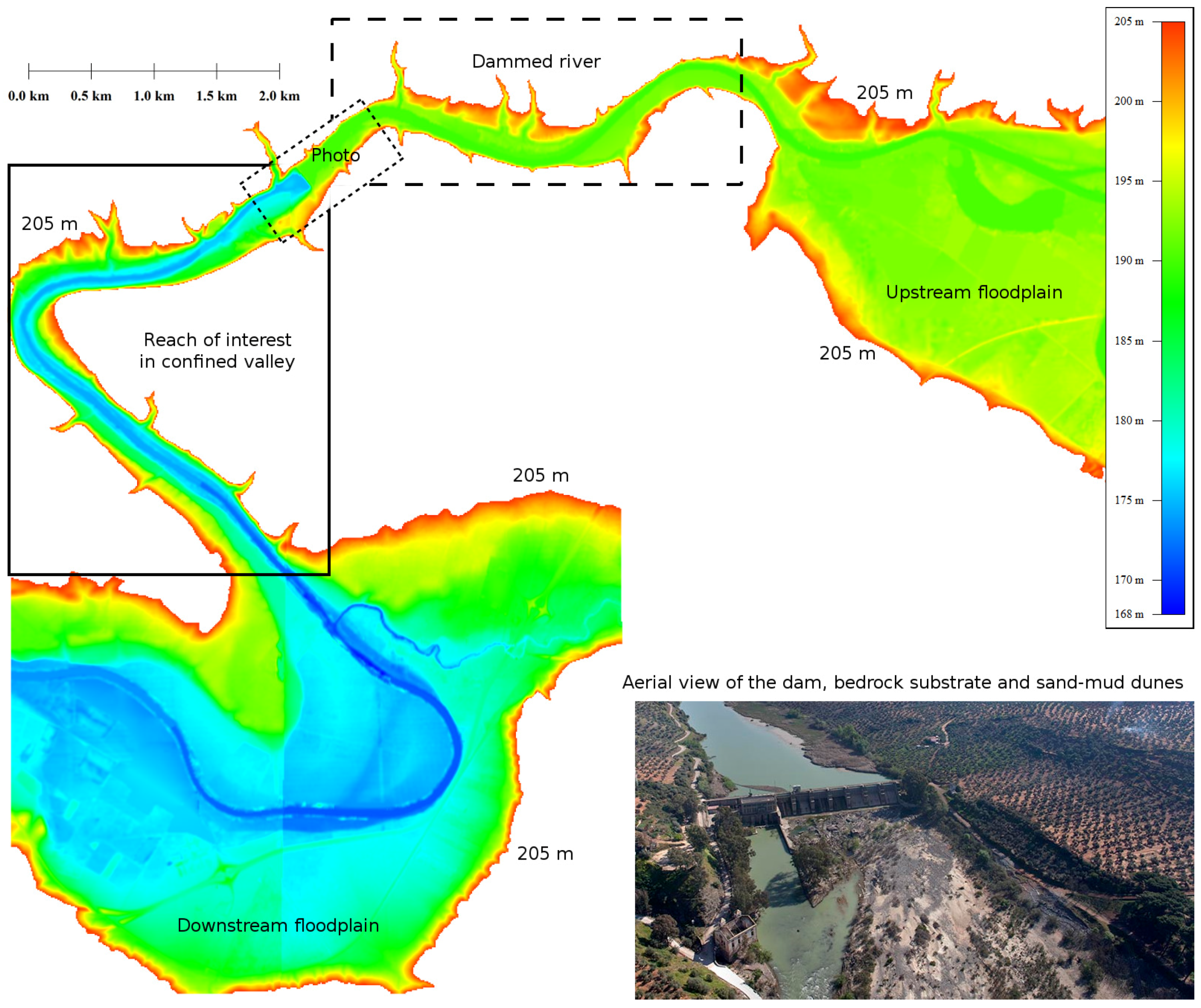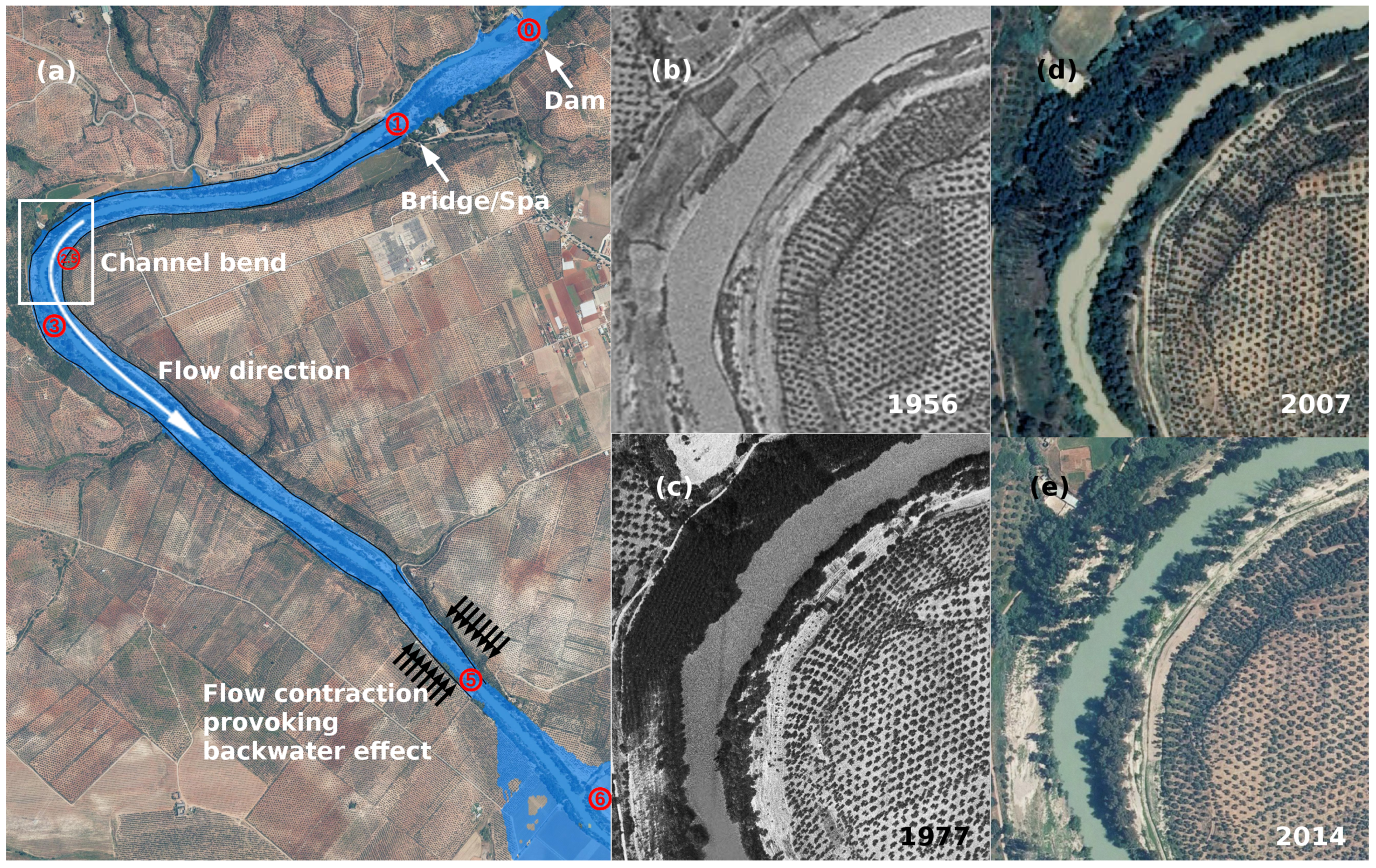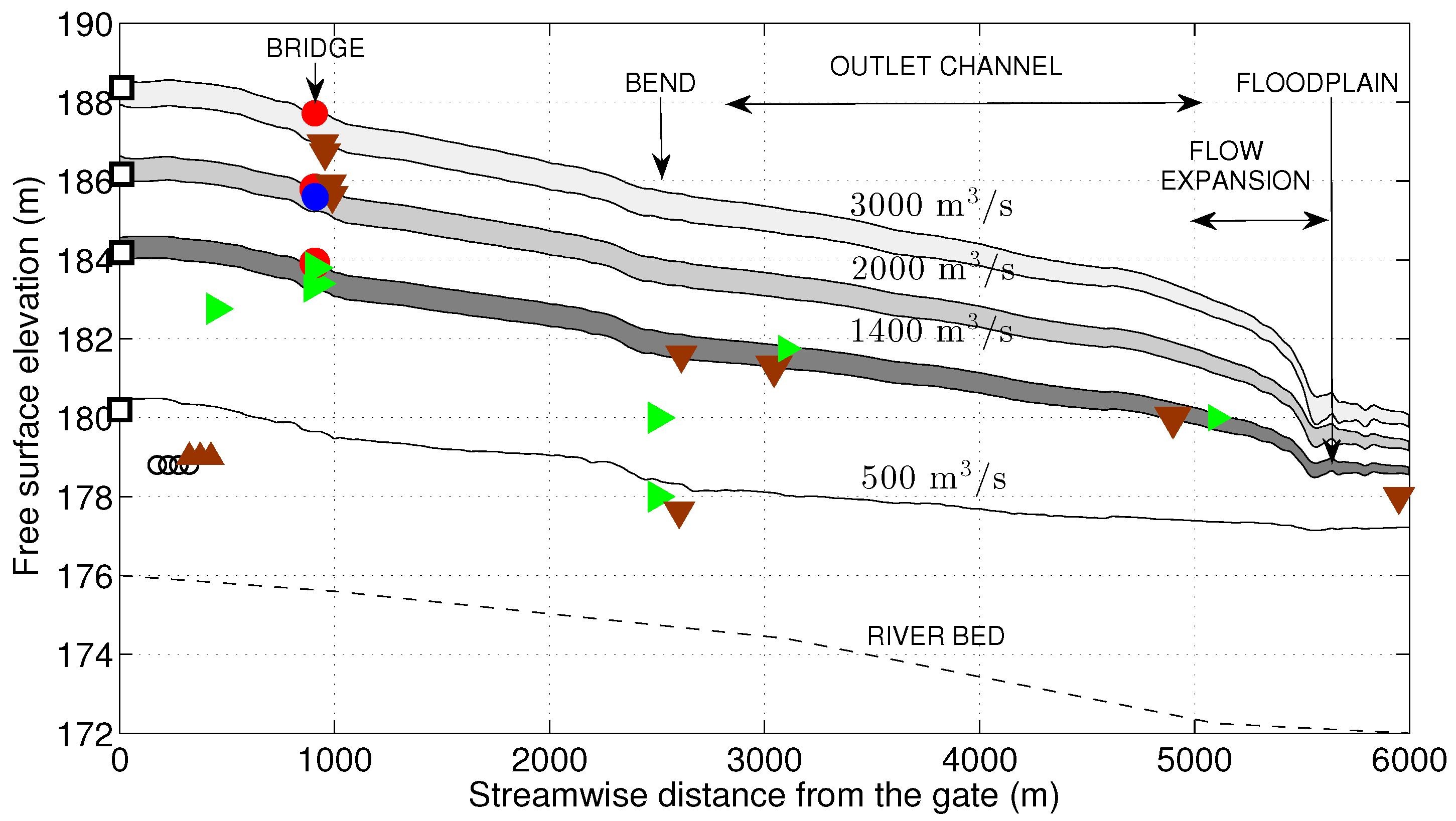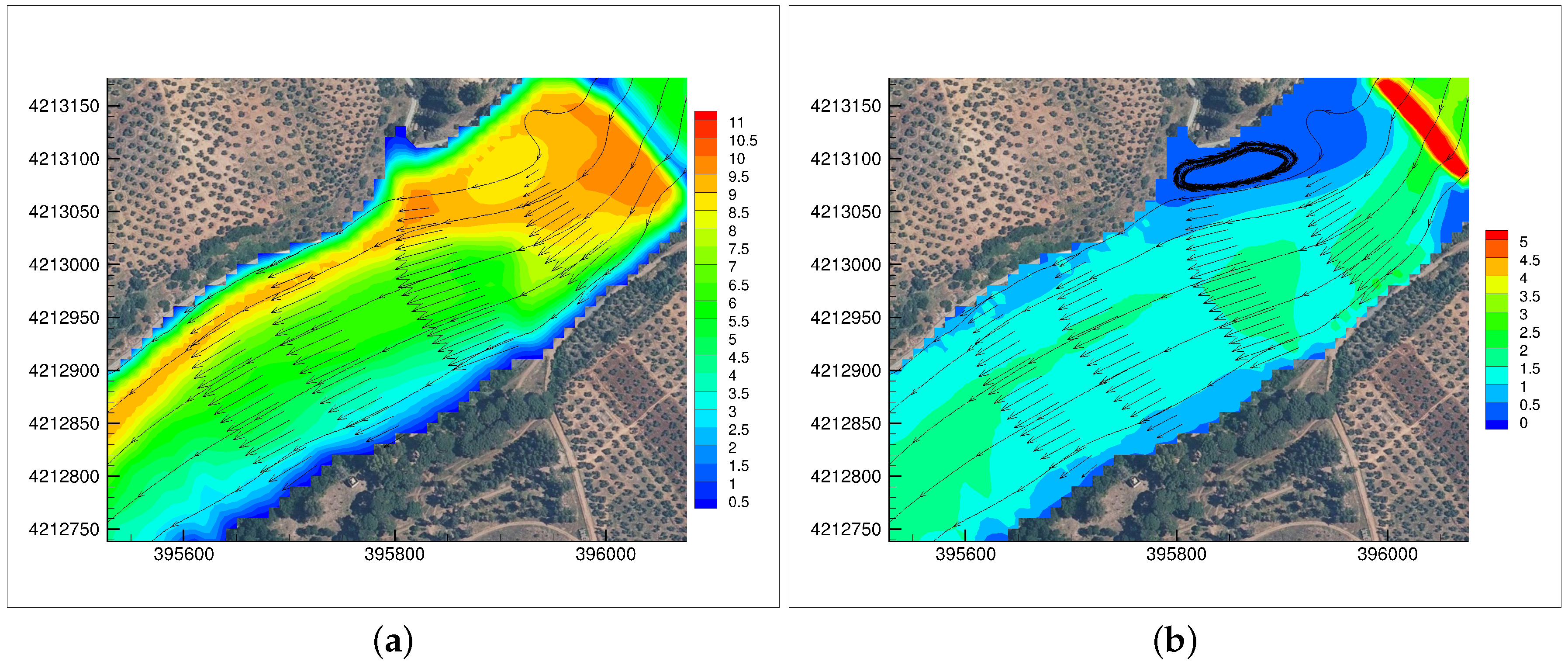Paleohydraulic Reconstruction of Modern Large Floods at Subcritical Speed in a Confined Valley: Proof of Concept
Abstract
:1. Introduction
2. Materials and Methods
2.1. Study Area
- The study site must be selected in order that the flood discharge increases result in large increases in the stage. Thus, the confined channel is more preferred than the floodplains. Indeed, an increase in the water discharge from 1400 to 3000 m3s−1 implies an increase in depth of 4 m in the main channel of the confined valley analysed herein (see Section 3).
- It is important to find key control reaches with stable cross-sections and well-preserved high-water indicators. Subsequently, a channel with exposed slate substrate and bedrock gorge was selected in this study, allowing the use of two-dimensional shallow water equations over fixed bed in the hydraulic reconstruction [3,8].
2.2. Gauging Records
2.3. Imagery and Documentary Evidence
2.4. Sedimentary Sequences and Botanical High Watermarks
2.5. Two-Dimensional Shallow Water Modelling, Computational Mesh and Boundary Conditions
3. Results
3.1. Systematic, Historical and Paleostage Flood Records
- The lack of bedforms and fine sediment deposits in the first river reach indicates a transport capacity larger than sediment supply. Only woody debris and a siltline are preserved at elevated bedrock terraces (9 m above the thalweg) or anthropogenic platforms (i.e., roads) below the dam. Surface gravel structures were formed by pebble to cobble grain-sized angular clasts. Downstream imbricated clasts support the argument of low sediment supply to sediment capacity ratio [59]. The high sediment transport capacity below the dam could be associated with the extreme turbulent intensity of the water down the spillways which was able to resuspend fine sediments [60].
- A field of sandy mud bumps developed on a bedrock bench further downstream. Bumps of cohesive mixtures of mud and sand are preserved downstream of flow obstacles (i.e., downstream flexible-wood trees such as Tamarix sp. and Fraxinus sp.). Shrubs on the bumps could initiate the accumulation of sediments as happens in obstacle dune. The bedforms resemble linear or long straight dunes. They are elongated along the longitudinal axis, being the width and height of the bumps much shorter than its longitudinal length.
- Overbank flood-deposited sediments downstream of the bridge ( m) was identified as a sedimentary evidence of flood level with the depth of 11 m. The documentary rating curve in Figure 3a indicates that the corresponding water discharge should be m3s−1.
- Bank erosion also developed further downstream, on the inner side of the natural river bend ( m). The photograph and the 3D representation of the bend shown in Figure 5a and Figure 7b, respectively, illustrate the lateral sediment bar that formed at the bottom of the inner bank. The elevation of the sediment bar measured during fieldworks (≈178 m) is in good agreement with the LiDAR data shown in Figure 7a. The top of the riverbanks at the bend (≈182 m) is elevated 8 m above the thalweg.
- Laterally-attached sandy siltlines were deposited from the end of the bend up to the flow expansion area ( m) during the April 2013 flood. Their locations could be readily identified in the most recent orthophoto (see the solid line in black in Figure 4a) and the elevations could be inferred based on the LiDAR data. For the sake of the brevity, the elevations are shown in Figure 6 only at the beginning and at the end of the sediment deposits.
- Botanical HWMs are depicted with green right triangles in Figure 6. Figure 5b shows an illustrative example which was identified in the flow contraction area of the outlet channel (see location in Figure 4a). These botanical records are consistent with other flow stage indicators as the top level of lateral bars and imagery for the flood occurred in April 2013.
3.2. Calibration of the Numerical Model Pre- and Post-Vegetation Encroachment
3.3. Verification of the Simulated Floods with PSIs
4. Conclusions
- Following Blocken and Gualtieri [30], high-quality experimental data are indispensable for the validation of any computational river dynamics model. Jarrett and England [14] showed that the elevation at the flood-deposited sediments nearest to channel margins provides a reliable and accurate indication of the maximum height of the flood. Hence, sedimentological HWMs can be used to check the accuracy and reliability of the 2D Saint-Venant equations in paleohydrology.
- Botanical HWMs provide valuable data for understanding recent floods and reconstructing their spatial patterns but botanical PSIs are perishable, might be washed out by more extreme floods and need to be preserved, as recently pointed out by Koenig et al. [16].
- Comparison with documentary data and imagery demonstrates that botanical and sedimentological HWMs, as well as mud-lines on man-made structures, are reliable data to indicate flood stages. Furthermore, the rating curve obtained from the combined use of 2D numerical simulations and imagery was nearly as accurate as gauging measurements.
- Overbank flood-deposited sediments are the only PSIs that record the most extreme flood. Interestingly, the simulated water depth of the largest flood in this study is much higher than in Jarrett and England’s [14] work (12 m vs. 4.5 m), and closely matches the observed flood stage, confirming previous findings on the reliability of PSI-HWMs for paleoflood studies.
- Dunes, imbricated pebbles and lateral bars are indirect indicators of the hydraulic conditions. Usually, flow depth and velocity magnitude for a given bedform dimension are deduced from dimensionless correlations under uniform and steady flow conditions [13,60]. However, PSIs are uncorrelated with these universal laws in non-uniform flows.
Acknowledgments
Conflicts of Interest
References
- Baker, V.R. Paleoflood hydrology: Origin, progress, prospects. Geomorphology 2008, 101, 1–13. [Google Scholar] [CrossRef]
- Carrivick, J.L. Application of 2D hydrodynamic modelling to high–magnitude outburst floods: An example from Kverkfjöll, Iceland. J. Hydrol. 2006, 321, 187–199. [Google Scholar] [CrossRef]
- Bohorquez, P.; Darby, S.E. The use of one– and two–dimensional hydraulic modelling to reconstruct a glacial outburst flood in a steep Alpine valley. J. Hydrol. 2008, 361, 240–261. [Google Scholar] [CrossRef]
- Westoby, M.J.; Glasser, N.F.; Brasington, J.; Hambrey, M.J.; Quincey, D.J.; Reynolds, J.M. Modelling outburst floods from moraine-dammed glacial lakes. Earth-Sci. Rev. 2014, 134, 137–159. [Google Scholar] [CrossRef]
- Baker, V.R.; Benito, G.; Rudoy, A.N. Paleohydrology of late Pleistocene superflooding, Altay Mountains, Siberia. Science 1993, 259, 348–350. [Google Scholar] [CrossRef] [PubMed]
- Herget, J. Reconstruction of Pleistocene ice-dammed lake outburst floods in the Altai Mountains, Siberia. Spec. Pap. Geol. Soc. Am. 2005, 386, 1–118. [Google Scholar]
- Carling, P.A.; Villanueva, I.; Herget, J.; Wright, N.; Borodavko, P.; Morvan, H. Unsteady 1D and 2D hydraulic models with ice dam break for Quaternary megaflood, Altai Mountains, southern Siberia. Glob. Planet. Chang. 2010, 70, 24–34. [Google Scholar] [CrossRef]
- Bohorquez, P.; Carling, P.A.; Herget, J. Dynamic simulation of catastrophic late Pleistocene glacial-lake drainage, Altai Mountains, central Asia. Int. Geol. Rev. 2016, 58, 1795–1817. [Google Scholar] [CrossRef]
- Benito, G.; Lang, M.; Barriendos, M.; Llasat, M.; Francés, F.; Ouarda, T.; Thorndycraft, V.R.; Enzel, Y.; Bardossy, A.; Coeur, D.; et al. Use of systematic, palaeoflood and historical data for the improvement of flood risk estimation. Review of scientific method. Nat. Hazards 2004, 31, 623–643. [Google Scholar]
- Baker, V.R. Paleoflood hydrology and extraordinary flood events. J. Hydrol. 1987, 96, 79–99. [Google Scholar] [CrossRef]
- Lumbroso, D.; Gaume, E. Reducing the uncertainty in indirect estimates of extreme flash flood discharges. J. Hydrol. 2012, 414–415, 16–30. [Google Scholar] [CrossRef]
- Bohorquez, P.; García-García, F.; Pérez-Valera, F.; Martínez-Sánchez, C. Unsteady two–dimensional paleohydraulic reconstruction of extreme floods over the last 4000 yr in Segura River, southeast Spain. J. Hydrol. 2013, 447, 229–239. [Google Scholar] [CrossRef]
- Carling, P.A. Freshwater megaflood sedimentation: What can we learn about generic processes? Earth Sci. Rev. 2013, 125, 87–113. [Google Scholar] [CrossRef]
- Jarrett, R.D.; England, J.F. Reliability of paleostage indicators for paleoflood studies. In Ancient Floods, Modern Hazards; House, P.K., Ebb, R.H., Baker, V.R., Levish, D.R., Eds.; Water Science and Application; American Geophysical Union: Washington, DC, USA, 2002; pp. 91–109. [Google Scholar]
- Carling, P.A.; Burr, D.M.; Johnsen, T.F.; Brennand, T.A. A review of open-channel megaflood depositional landforms on Earth and Mars. In Megaflooding on Earth and Mars; Burr, D., Carling, P.A., Baker, V.R., Eds.; Cambridge University Press: Cambridge, UK, 2009; pp. 33–49. [Google Scholar]
- Koenig, T.A.; Bruce, J.L.; O’Connor, J.; McGee, B.D.; Holmes, R.R., Jr.; Hollins, R.; Forbes, B.T.; Kohn, M.S.; Schellekens, M.; Martin, Z.W.; et al. Identifying and preserving high-water mark data. U.S. Geol. Surv. Tech. Methods 2016. [Google Scholar] [CrossRef]
- Brázdil, R.; Kundzewicz, Z.W.; Benito, G. Historical hydrology for studying flood risk in Europe. Hydrol. Sci. J. 2006, 51, 739–764. [Google Scholar] [CrossRef]
- Hall, J.; Arheimer, B.; Borga, M.; Brázdil, R.; Claps, P.; Kiss, A.; Kjeldsen, T.R.; Kriauciuniene, J.; Kundzewicz, Z.W.; Lang, M.; et al. Understanding flood regime changes in Europe: A state-of-the-art assessment. Hydrol. Earth Syst. Sci. 2014, 18, 2735–2772. [Google Scholar] [CrossRef] [Green Version]
- Kjeldsen, T.R.; Macdonald, N.; Lang, M.; Mediero, L.; Albuquerque, T.; Bogdanowicz, E.; Brzdil, R.; Castellarin, A.; David, V.; Flei, A.; et al. Documentary evidence of past floods in Europe and their utility in flood frequency estimation. J. Hydrol. 2014, 517, 963–973. [Google Scholar] [CrossRef] [Green Version]
- Benito, G.; Brázdil, R.; Herget, J.; Machado, M.J. Quantitative historical hydrology in Europe. Hydrol. Earth Syst. Sci. 2015, 19, 3517–3539. [Google Scholar] [CrossRef]
- Toonen, W.H.J.; Middelkoop, H.; Konijnendijk, T.Y.M.; Macklin, M.G.; Cohen, K.M. The influence of hydroclimatic variability on flood frequency in the Lower Rhine. Earth Surf. Process. Landf. 2016, 41, 1266–1275. [Google Scholar] [CrossRef]
- Denlinger, R.P.; O’Connell, D.R.H.; House, P.K. Robust determination of stage and discharge: An example from an extreme flood on the Verde River, Arizona. In Ancient Floods, Modern Hazards; House, P.K., Ebb, R.H., Baker, V.R., Levish, D.R., Eds.; Water Science and Application; American Geophysical Union: Washington, DC, USA, 2002; pp. 127–146. [Google Scholar]
- Alho, P.; Baker, V.R.; Smith, L.N. Paleohydraulic reconstruction of the largest Glacial Lake Missoula draining(s). Quat. Sci. Rev. 2010, 29, 3067–3078. [Google Scholar] [CrossRef]
- Denlinger, R.P.; O’Connell, D.R.H. Simulations of cataclysmic outburst floods from Pleistocene glacial lake Missoula. Bull. Geol. Soc. Am. 2010, 122, 678–689. [Google Scholar] [CrossRef]
- Winsemann, J.; Alho, P.; Laamanen, L.; Goseberg, N.; Lang, J.; Klostermann, J. Flow dynamics, sedimentation and erosion of glacial lake outburst floods along the Middle Pleistocene Scandinavian Ice Sheet (northern central Europe). Boreas 2016, 45, 260–283. [Google Scholar] [CrossRef]
- Feldman, A.D. HEC models for water resources system system simulation: theory and experience. Adv. Hydrosci. 1981, 12, 297–423. [Google Scholar]
- Herget, J.; Roggenkamp, T.; Krell, M. Estimation of peak discharges of historical floods. Hydrol. Earth Syst. Sci. 2014, 18, 4029–4037. [Google Scholar] [CrossRef] [Green Version]
- Couderc, F.; Madec, R.; Martin, N.; Monnier, J.; Vila, J.P.; Dartus, D.; Honnorat, M.; Marin, J. DassFlow: Data Assimilation for Free Surface Flows. Available online: http://www-gmm.insa-toulouse.fr/∼monnier/DassFlow (accessed on 1 September 2014).
- Monnier, J.; Couderc, F.; Dartus, D.; Larnier, K.; Madec, R.; Vila, J.P. Inverse algorithms for 2D shallow water equations in presence of wet dry fronts. Application to flood plain dynamics. Adv. Water Res. 2016, 97, 11–24. [Google Scholar] [CrossRef]
- Blocken, B.; Gualtieri, C. Ten iterative steps for model development and evaluation applied to Computational Fluid Dynamics for Environmental Fluid Mechanics. Environ. Model. Softw. 2012, 33, 1–22. [Google Scholar] [CrossRef]
- Darby, S.E. Effect of riparian vegetation on flow resistance and flood potential. J. Hydraul. Eng. 1999, 125, 443–454. [Google Scholar] [CrossRef]
- Sanders, B.F. Evaluation of on-line DEMs for flood inundation modeling. Adv. Water Resour. 2007, 30, 1831–1843. [Google Scholar] [CrossRef]
- Blayo, E.; Debreu, L. Revisiting open boundary conditions from the point of view of characteristic variables. Ocean Model. 2005, 9, 231–252. [Google Scholar] [CrossRef]
- Barredo, J.; Saurand, D.; Llasat, M. Assessing trends in insured losses from floods in Spain 1971–2008. Nat. Hazards Earth Syst. Sci. 2012, 12, 1723–1729. [Google Scholar] [CrossRef] [Green Version]
- Benito, G.; Machado, M.J. Floods in the Iberian Peninsula. In Changes in Flood Risk in Europe; IAHS Special Publication 10; Kundzewicz, Z.W., Ed.; IAHS Press and CRC Press/Balkema: Wallingford, UK, 2012; pp. 372–383. [Google Scholar]
- Instituto Geológico y Minero de España (IGME). Análisis del Impacto de los Riegos Geológicos en España. Evaluación de Pérdidas por Terremotos e Inundaciones en el Periodo 1987–2001 y Estimación Para el Periodo 2004–2033; Instituto Geológico y Minero de España (IGME), Ministerio de Educación y Ciencia, Consorcio de Compensación de Seguros: Madrid, Spain, 2004. [Google Scholar]
- Gilbert, G.K. The transportation of débris by running water. U.S. Geol. Surv. Prof. Pap. 1914, 86, 263. [Google Scholar]
- Baker, V.R.; Kale, V.S. The role of extreme floods in shaping bedrock channels. In Rivers over Rock: Fluvial Processes in Bedrock Channels; Tinkler, K.J., Wohl, E.E., Eds.; American Geophysical Union: Washington, DC, USA, 1998; pp. 153–165. [Google Scholar]
- Church, M. Bed material transport and the morphology of alluvial river channels. Annu. Rev. Earth Planet. Sci. 2006, 34, 325–354. [Google Scholar] [CrossRef]
- Buffington, J.M.; Montgomery, D.R. Geomorphic classification of rivers. In Treatise on Geomorphology; Shroder, J., Wohl, E., Eds.; Fluvial Geomorphology; Academic Press: San Diego, CA, USA, 2013; Volume 9, pp. 730–767. [Google Scholar]
- Davidian, J. Computation of Water Surface Profiles in Open Channels; USGS TWRI Book 3: Application of Hydraulics. Ch. A15; United States Geological Survey: Washington, DC, USA, 1984.
- Vannéy, J.R. L’hydrologie du bas Guadalquivir; Consejo Superior de Investigaciones Científicas: Madrid, Spain, 1970. [Google Scholar]
- Sistema de Información del Anuario de Aforos. Available online: http://sig.magrama.es/aforos (accessed on 1 September 2015).
- Sistema Automático de Información Hidrológica de la Cuenca del Guadalquivir. Available online: http://www.chguadalquivir.es/saih/ (accessed on 1 September 2015).
- Pascual, G.; Bustamante, A. Catálogo Nacional de Inundaciones Históricas. Actualización; Nipo: 126-11-150-1; Ministerio del Interior: Madrid, Spain, 2011. [Google Scholar]
- Uribelarrea, D.; Benito, G. Fluvial changes of the Guadalquivir river during the Holocene in Córdoba (Southern Spain). Geomorphology 2008, 100, 14–31. [Google Scholar] [CrossRef]
- Borja Palomo, F.D. Memoria Histórico-Crítico Sobre las Riadas o Grandes Avenidas del Guadalquivir en Sevilla, Desde Principio del Siglo XV hasta Nuestros días; Excmo. Ayto de Sevilla: Sevilla, Spain, 1877. [Google Scholar]
- Infraestructura de Datos Espaciales de Andalucía. Available online: http://www.ideandalucia.es/IDEAvisor (accessed on 1 September 2015).
- Bohorquez, P.; Aranda, V.; Calero, J.; García-García, F.; Ruiz-Ortiz, P.; Fernández, T.; Salazar, C. Floods in the Guadalquivir River (Southern Spain). In Proceedings of the International Conference on Fluvial Hydraulics, RIVER FLOW 2014, Lausanne, Switzerland, 3–5 September 2014; Schleiss, A., Cesare, G., Franca, M., Pfister, M., Eds.; CRC Press/Balkema: Leiden, The Netherlands, 2014; pp. 1711–1719. [Google Scholar]
- Wu, W. Computation River Dynamics; Taylor & Francis: London, UK, 2007. [Google Scholar]
- Courant, R.; Friedrichs, K.; Lewy, H. On the partial difference equations of mathematical physics. IBM J. Res. Dev. 1967, 11, 215–234. [Google Scholar] [CrossRef]
- Plan Nacional de Ortofotografía Aérea, Instituto Geográfico Nacional de España. Available online: http://www.ign.es/PNOA (accessed on 1 September 2014).
- Huang, W.; Cao, Z.X.; Carling, P.A.; Pender, G. Coupled 2D hydrodynamic and sediment transport modelling of megaflood due to glacier dam-break in Altai Mountains, Southern Siberia. J. Mt. Sci. 2014, 11, 1442–1453. [Google Scholar] [CrossRef]
- Guan, M.; Wright, N.; Sleigh, P.; Carrivick, J. Assessment of hydro-morphodynamic modelling and geomorphological impacts of a sediment-charged jökulhlaup, at Sólheimajökull, Iceland. J. Hydrol. 2015, 530, 336–349. [Google Scholar] [CrossRef]
- Bohorquez, P.; Ancey, C. Particle diffusion in non-equilibrium bedload transport simulations. Appl. Math. Model. 2016, 40, 7474–7492. [Google Scholar] [CrossRef]
- Heyman, J.; Bohorquez, P.; Ancey, C. Entrainment, motion and deposition of coarse particles transported by water over a sloping mobile bed. J. Geophys. Res. Earth Surf. 2016, 121, 1931–1952. [Google Scholar] [CrossRef]
- Alho, P.; Aaltonen, J. Comparing a 1D hydraulic model with a 2D hydraulic model for the simulation of extreme glacial outburst floods. Hydrol. Process. 2008, 22, 1537–1547. [Google Scholar] [CrossRef]
- Petts, G.E. Long-term consequences of upstream impoundment. Environ. Conserv. 1980, 7, 325–332. [Google Scholar] [CrossRef]
- Hassan, M.; Church, M. Experiments on surface structure and partial sediment transport on a gravel bed. Water Resour. Res. 2000, 36, 1885–1895. [Google Scholar] [CrossRef]
- Yalin, M.S.; da Silva, A.M.F. Fluvial Processes; IAHR Monograph, IAHR: Delft, The Netherlands, 2001. [Google Scholar]
- O’Connor, J.E.; Webb, R.H. Hydraulic modeling for paleoflood analysis. In Flood Geomorphology; Baker, V.R., Kochel, R.C., Patton, P.C., Eds.; John Wiley and Sons: New York, NY, USA, 1988; pp. 393–402. [Google Scholar]
- Arcement, G.J., Jr.; Schneider, V.R. Guide for Selecting Manning’s Roughness Coefficients for Natural Channels and Flood Plains; U.S. Geological Survey Water-Supply Paper; United States Government Printing Office: Denver, CO, USA, 1989; Volume 2339.
- Whitham, G.B. Linear and Nonlinear Waves; John Wiley & Sons: New York, NY, USA, 1974. [Google Scholar]
- Baas, J.H.; Davies, A.G.; Malarkey, J. Bedform development in mixed sand-mud: The contrasting role of cohesive forces in flow and bed. Geomorphology 2013, 182, 19–32. [Google Scholar] [CrossRef]
- Baas, J.H.; Best, J.L.; Peakall, J. Predicting bedforms and primary current stratification in cohesive mixtures of mud and sand. J. Geol. Soc. 2015. [Google Scholar] [CrossRef]
- Slater, L.J.; Singer, M.B.; Kirchner, J.W. Hydrologic versus geomorphic drivers of trends in flood hazard. Geophys. Res. Lett. 2015, 42, 2014GL062482. [Google Scholar] [CrossRef]
- Naylor, L.A.; Spencer, T.; Lane, S.N.; Darby, S.E.; Magilligan, F.J.; Macklin, M.G.; Möller, I. Stormy Geomorphology: Geomorphic contributions in an age of climate extremes. Earth Surf. Process. Landf. 2016. [Google Scholar] [CrossRef]








© 2016 by the author; licensee MDPI, Basel, Switzerland. This article is an open access article distributed under the terms and conditions of the Creative Commons Attribution (CC-BY) license (http://creativecommons.org/licenses/by/4.0/).
Share and Cite
Bohorquez, P. Paleohydraulic Reconstruction of Modern Large Floods at Subcritical Speed in a Confined Valley: Proof of Concept. Water 2016, 8, 567. https://doi.org/10.3390/w8120567
Bohorquez P. Paleohydraulic Reconstruction of Modern Large Floods at Subcritical Speed in a Confined Valley: Proof of Concept. Water. 2016; 8(12):567. https://doi.org/10.3390/w8120567
Chicago/Turabian StyleBohorquez, Patricio. 2016. "Paleohydraulic Reconstruction of Modern Large Floods at Subcritical Speed in a Confined Valley: Proof of Concept" Water 8, no. 12: 567. https://doi.org/10.3390/w8120567





